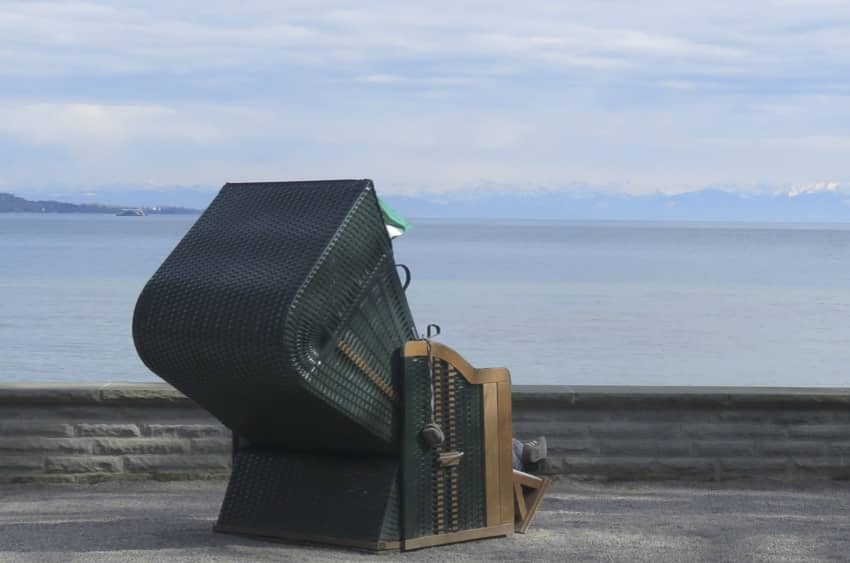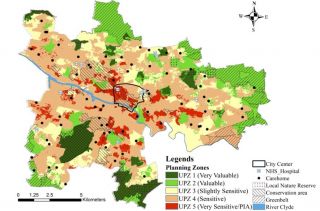
www.buildingsandcities.org/insights/commentaries/cop26-microclimate.html
Adapting our Cities and Urban Planning to Climate Change: Microclimates

By Michael Donn (Victoria University Wellington, NZ)
The complex and dynamic interactions between 3-D built form and the local environment must be accounted for in planning decisions to create pleasant, resilience microclimates for now and the future. Present planning procedures are over-simplistic and unsuitable. New approaches are suggested.
When a scientific consensus reaches the popular press, we risk drowning in attention-grabbing headlines. This is the city managers' dilemma with urban design under climate change. Even IPCC publications headline the disasters: increased flooding; more heat waves; more and stronger storms; and more regular, and deeper droughts and wildfires. But what of everyday resilience? Between these extreme events, what will our cities be like day-to-day with the required measures in place?
Prior to writing this, a quick snowball search revealed over 750 references. This is too much for the city planner to use. There was also little consensus amongst those papers that did not rely on unsubstantiated models, and those that did not just repeat conventional broad brush platitudes.
An often-adopted mantra proposes that to reduce climate change disasters we should green our cities urban spaces, and buildings (with green roofs and walls). Architecture has a storied history of building designs and urban forms that work well in a particular context, but if transferred to another site there is a spectacular lack of success. Even a cursory glance at recent publications reveals a likelihood of history repeating. Numerous papers question our current building performance models. And much of the rest, using some empirical measurement and a large amount of modelling, examines locations where the green city slogan is at best marginal.
The 'green the city' mantra is targeted primarily at cooling - reducing the extremes of heat waves. It assumes the problem is the Urban Heat Island (UHI). Trapped solar heat in the streets and buildings, and heat pumped out of the buildings by air conditioning increase the UHI effect. This, it is argued, risks higher heat stress death rates as climate change leads to temperature rise.
The slogan is simplicity itself. Grass not asphalt provides some city cooling. Shade trees that people can walk or sit under provide more. For short buildings, the cool air under an adjacent tree canopy provides a cool street, which with the solar shade reduces the need for air conditioning, providing a double benefit in reducing UHI. But, to be truly effective the trees need to be shading all the building, not merely the lower floors; and the analyses look at worst summer situations, ignoring winters in cooler climates.
These are, however, minor issues. The real issue is that this type of solution will regularly fail if it is transferred from city to city without thought as to the intertwined concepts of building type and climate. Climates classifications such as "hot humid", "hot dry", "cool temperate", or "cold" derive from crop growing not the reality of the urban building. Buildings in a cool temperate climate may pose a largely-heating or a largely-cooling design challenge. For example, the heat generated by people, lights and equipment inside an office building may make the cold air of a "cool" climate a welcome means of cooling. An apartment building of the same dimensions would pose a heating challenge which the cold outside air makes worse.
The solution is getting rid of criminally negligent city planning formulae that provide landowners with a right to build to a certain height, or bulk on an urban site. City building rules should focus on the creation of future outdoor environments for people to enjoy. When done well, these environments will also provide a low carbon, sustainable future because they reduce the effects on the planet of the buildings defining these environments.
To do this, all cities need to document their existing regional environment, and its interaction with buildings. This requires continuous and widespread monitoring of the horizontal and the vertical distribution of sun, wind, temperature, humidity and particulate pollution using, say, Internet of Things technology. These need to be deployed horizontally across the city and vertically as high as the tallest buildings. Too often, UHI effects are "documented" as a 7-10 oC warmer city centre compared to the surrounding countryside, with no picture of the variation of wind or temperature at height. Detailed mapping at the micro level should note where places are cold in winter, or too hot in summer, or ventilated by cool breezes.
Planners assessing a building proposal need data from designers on the effects of these environments on comfort indoors. They also want to know its effect on these monitored urban environmental factors. For example: In a future storm, will that new building create unpleasant drafts in winter? Or dangerous winds? Or provide regular accelerated breezes that remove pollution? Which areas are to be retained or developed as cool gathering places in summer and warm in winter? Does the new building "ventilate" the street of pollutants.
A multi-factor analysis of the impact of each new building on the city now and in 50 years' time is essential to our future resilient cityscapes. In the context of the existing environment and the city's environmental goals, this data becomes useful in planning permission discussion.Latest Peer-Reviewed Journal Content
A framework for 1.5°C-aligned GHG budgets in architecture
G Betti, I Spaar, D Bachmann, A Jerosch-Herold, E Kühner, R Yang, K Avhad & S Sinning
Net zero retrofit of the building stock [editorial]
D Godoy-Shimizu & P Steadman
Co-learning in living labs: nurturing civic agency and resilience
A Belfield
The importance of multi-roles and code-switching in living labs
H Noller & A Tarik
Researchers’ shifting roles in living labs for knowledge co-production
C-C Dobre & G Faldi
Increasing civic resilience in urban living labs: city authorities’ roles
E Alatalo, M Laine & M Kyrönviita
Co-curation as civic practice in community engagement
Z Li, M Sunikka-Blank, R Purohit & F Samuel
Preserving buildings: emission reductions from circular economy strategies in Austria
N Alaux, V Kulmer, J Vogel & A Passer
Urban living labs: relationality between institutions and local circularity
P Palo, M Adelfio, J Lundin & E Brandão
Living labs: epistemic modelling, temporariness and land value
J Clossick, T Khonsari & U Steven
Co-creating interventions to prevent mosquito-borne disease transmission in hospitals
O Sloan Wood, E Lupenza, D M Agnello, J B Knudsen, M Msellem, K L Schiøler & F Saleh
Circularity at the neighbourhood scale: co-creative living lab lessons
J Honsa, A Versele, T Van de Kerckhove & C Piccardo
Positive energy districts and energy communities: how living labs create value
E Malakhatka, O Shafqat, A Sandoff & L Thuvander
Built environment governance and professionalism: the end of laissez-faire (again)
S Foxell
Co-creating justice in housing energy transitions through energy living labs
D Ricci, C Leiwakabessy, S van Wieringen, P de Koning & T Konstantinou
HVAC characterisation of existing Canadian buildings for decarbonisation retrofit identification
J Adebisi & J J McArthur
Simulation and the building performance gap [editorial]
M Donn
Developing criteria for effective building-sector commitments in nationally determined contributions
P Graham, K McFarlane & M Taheri
Reimagining circularity: actions for optimising the use of existing buildings
R Lundgren, R Kyrö, S Toivonen & L Tähtinen
Effective interdisciplinary stakeholder engagement in net zero building design
S Vakeva-Baird, F Tahmasebi, JJ Williams & D Mumovic
Metrics for building component disassembly potential: a practical framework
H Järvelä, A Lehto, T Pirilä & M Kuittinen
The unfitness of dwellings: why spatial and conceptual boundaries matter
E Nisonen, D Milián Bernal & S Pelsmakers
Environmental variables and air quality: implications for planning and public health
H Itzhak-Ben-Shalom, T Saroglou, V Multanen, A Vanunu, A Karnieli, D Katoshevski, N Davidovitch & I A Meir
Exploring diverse drivers behind hybrid heating solutions
S Kilpeläinen, S Pelsmakers, R Castaño-Rosa & M-S Miettinen
Urban rooms and the expanded ecology of urban living labs
E Akbil & C Butterworth
Living with extreme heat: perceptions and experiences
L King & C Demski
A systemic decision-making model for energy retrofits
C Schünemann, M Dshemuchadse & S Scherbaum
Modelling site-specific outdoor temperature for buildings in urban environments
K Cebrat, J Narożny, M Baborska-Narożny & M Smektała
Understanding shading through home-use experience, measurement and modelling
M Baborska-Narożny, K Bandurski, & M Grudzińska
Building performance simulation for sensemaking in architectural pedagogy
M Bohm
Beyond the building: governance challenges in social housing retrofit
H Charles
Heat stress in social housing districts: tree cover–built form interaction
C Lopez-Ordoñez, E Garcia-Nevado, H Coch & M Morganti
An observational analysis of shade-related pedestrian activity
M Levenson, D Pearlmutter & O Aleksandrowicz
Learning to sail a building: a people-first approach to retrofit
B Bordass, R Pender, K Steele & A Graham
Market transformations: gas conversion as a blueprint for net zero retrofit
A Gillich
Resistance against zero-emission neighbourhood infrastructuring: key lessons from Norway
T Berker & R Woods
Megatrends and weak signals shaping future real estate
S Toivonen
A strategic niche management framework to scale deep energy retrofits
T H King & M Jemtrud
Generative AI: reconfiguring supervision and doctoral research
P Boyd & D Harding
Exploring interactions between shading and view using visual difference prediction
S Wasilewski & M Andersen
How urban green infrastructure contributes to carbon neutrality [briefing note]
R Hautamäki, L Kulmala, M Ariluoma & L Järvi
Implementing and operating net zero buildings in South Africa
R Terblanche, C May & J Steward
Quantifying inter-dwelling air exchanges during fan pressurisation tests
D Glew, F Thomas, D Miles-Shenton & J Parker
Western Asian and Northern African residential building stocks: archetype analysis
S Akin, A Eghbali, C Nwagwu & E Hertwich
Join Our Community

The most important part of any journal is our people – readers, authors, reviewers, editorial board members and editors. You are cordially invited to join our community by joining our mailing list. We send out occasional emails about the journal – calls for papers, special issues, events and more.
We will not share your email with third parties. Read more



Latest Commentaries
COP30 Report
Matti Kuittinen (Aalto University) reflects on his experience of attending the 2025 UN Conference of the Parties in Belém, Brazil. The roadmaps and commitments failed to deliver the objectives of the 2025 Paris Agreement. However, 2 countries - Japan and Senegal - announced they are creating roadmaps to decarbonise their buildings. An international group of government ministers put housing on the agenda - specifying the need for reduced carbon and energy use along with affordability, quality and climate resilience.
Building-Related Research: New Context, New Challenges
Raymond J. Cole (University of British Columbia) reflects on the key challenges raised in the 34 commissioned essays for Buildings & Cities 5th anniversary. Not only are key research issues identified, but the consequences of changing contexts for conducting research and tailoring its influence on society are highlighted as key areas of action.